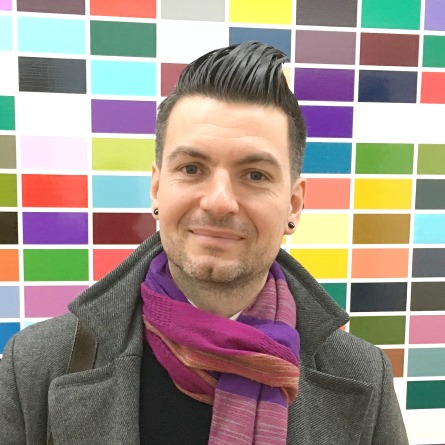Chris Barnard
Associate Professor of Art
Chair of the Art Department
Joined Connecticut College: 2012
Education
B.A., Yale University
Drawing
Two-dimensional art
Art history
U.S. militarization and imperialism
Critical discourse in contemporary art
Chris Barnard teaches Concepts in Two Dimensions; Drawing Fundamentals; Introduction to Painting; Figurative Painting & Its Politics; and Large Format Painting. His work has been shown in solo and group exhibitions in Los Angeles, New York City, San Diego, Chicago, and New Haven, and can be found in public and private collections nationally and internationally. He is represented by Fred Giampietro Gallery, New Haven, and Luis De Jesus Los Angeles.
Barnard was born in New York City and studied art, history and French language as an undergraduate at Yale and in Paris, France. After graduation, he returned to Paris to teach English in a public high school for one year. Upon returning to the U.S., he lived in New York for several years, working as a Web designer at NYU School of Medicine to support his painting practice, maintaining a studio in Williamsburg, Brooklyn.
Barnard moved to Los Angeles and received his M.F.A. from The University of Southern California (USC) in 2005. He then taught as adjunct faculty at Cal-State Dominguez Hills and worked for U.S. Senator Barbara Boxer in her Los Angeles office, designing, developing content for, and maintaining her official U.S. Senate website. From 2007-12, Barnard held full-time positions at Denison University (Ohio), Indiana University-Bloomington, and USC, while maintaining his Los Angeles studio.
Barnard came to Connecticut College as Assistant Professor of Art in 2012. He and his partner live in New Haven, Connecticut.
Artist's statement
Currently in my work I am focusing on white supremacy’s relationship to the privileged spaces of my experiences, such as private art and educational institutions. In our current political context, amidst ongoing public debates about race, power, and protests against its abuse, and widening gaps in wealth and opportunity, discussions about representation—across visual culture broadly—and its relationship to justice seem more relevant than ever.
In many of these compositions, which reference real sites, I have inserted fictional elements to raise questions about the allegiances and priorities of these institutions, as well as people—including myself—who have benefitted from, or continue to support them. The resulting works are representational, but through gestural passages and color and surface manipulation, I aim to suggest instability, corrosion and decay. In the end, I strive to make engaging paintings that suggest dissonance and ambivalence, that entice and challenge viewers, just as painting them does for me.
While formally distinct from my last abstract series, these new paintings share their precedents’ roots in contemplating Whiteness. These, too, emerge from wrestling with the politics of painting—the connections and gaps between painting and lived experience. These, too, reflect: a love of paint, the act of painting, and the power of the painted image; a regard for practitioners past and present, as well as those for whom practice has not been possible; and an admission of painting’s complicity with hegemonic power. As always, my process remains driven by questions. In this case, questions like: What role does painting play in the face of concrete social crises? How can my paintings respectfully incorporate—rather than exploit—relevant and thought-provoking content and imagery? What does it mean to think about racism, dehumanization, injustice, etc., and then to paint such pictures, and in particular as a straight, White man?
These questions and this body of work owe much to the work of others, and most acutely to three scholars’ books in particular: The History of White People, by Nell Irvin Painter; Ebony and Ivy: Race, Slavery, and the Troubled History of America’s Universities by Craig Steven Wilder; and The New Jim Crow: Mass Incarceration in the Age of Colorblindness, by Michelle Alexander. I am greatly indebted to the depth of research and insight that these books represent; each was inspiring as much as it was devastating. Along similar lines, I cannot fail to mention the power, impact and influence of artists like Kerry James Marshall, whose recent retrospective, Mastry, presented the scope of a body of work, and a window into an artistic practice, that I could not adequately honor in writing.
These people’s work, among others, influenced my own immeasurably, concretely sparking ideas for compositions, and more ephemerally—but equally importantly—by setting a standard, a tone, and a spirit for me in the studio that I strive to honor.
There is always danger in making art in response to inhumanity and suffering. I do so sincerely and humbly, without claiming success or certainty. And certainly, I recognize that painting has its limitations when compared to direct social action. That said, I believe art enables interaction and introspection for individuals, as well as creates opportunities for dialogue and discussion. My hope is that these works communicate a degree of internal struggle—among and between compositions, materials, processes, intents, and experiences—but, even more importantly, provoke conversation and critical thought.
To view Chris Barnard's work, visit his website: www.chrisbarnard.com/
Contact Chris Barnard
Mailing Address
Chris Barnard
Connecticut College
Box # ART/Cummings Arts Center
270 Mohegan Ave.
New London, CT 06320
Office
203 Cummings Arts Center
